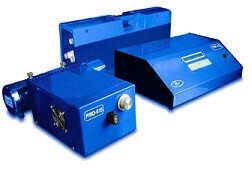-

-
 Thermospectra of mercury in bituminous coal from Vaal (SA4, total Hg 540 ppb) and Highveld (SA10, total Hg 195 ppb) coal fields (South Africa).
Thermospectra of mercury in bituminous coal from Vaal (SA4, total Hg 540 ppb) and Highveld (SA10, total Hg 195 ppb) coal fields (South Africa).
Environmental laboratory
Temperature profiling helps identify different species of mercury
Mar 17 2016
In environmental samples, mercury comes in various species. For example, in rocks, ores, soils, and sediments, mercury can occur in its synergetic form, bound to organic or inorganic matrices, sulfides, silica, carbonate minerals, and elemental Hg. These forms have different matrix binding energies and can be identified by the so-called thermoscanning technique based on real-time detection of mercury emission from a sample during gradual heating.
In a research project supported by the National Research Foundation of South Africa and the Russian Federation for Basic Research, more than 100 samples from 35 coal deposits were studied. The project helps us better understand the properties of coal, and proposes an efficiency enhancement for pre-combustion treatment to reduce emissions.
The analytical set consists of a standard RA-915M Zeeman mercury atomic absorption spectrometer coupled with a PYRO-915 pyrolysis attachment (Lumex Instruments). The special automated mode of the gradual heating of the PYRO-915 atomiser was developed and optimised to study mercury thermospecies in solid samples.
In the same analysis, the total mercury concentration is determined. The analysis of various types of samples reveals variously shaped mercury thermospectra. An example of such measurement of coal samples is shown on the figure below.
The low-temperature points can be attributed to mercury that has been bound by physical sorption and occluded. The mid- and high- temperature points occur due to mercury bound to organic coal matrices, sulfides, and silicates. The thermoscanning technique enables identifying mercury bound to pyrite and other sulfides and gives additional information about mercury speciation in samples.
The information obtained by thermoscanning may also be useful for other applications such as determining mercury species in mercury-contaminated soil, an important step in optimising remediation conditions.
For further information please contact us.
Digital Edition
IET 35.2 March
April 2025
Air Monitoring - Probe Sampling in Hazardous Areas Under Extreme Conditions - New, Game-Changing Sensor for Methane Emissions - Blue Sky Thinking: a 50-year Retrospective on Technological Prog...
View all digital editions
Events
Caspian International Power and Green Energy Exhibition
Jun 03 2025 Baku, Azerbaijan
Jun 04 2025 Koeln, Germany
Jun 04 2025 Shanghai, China
Jun 08 2025 Denver, CO, USA
Jun 09 2025 Raleigh, NC, USA


.jpg)





.jpg)









